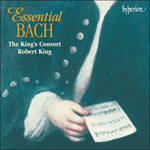With the Concerto in C minor for oboe and violin we have a work for which no original source exists. However, knowing that Bach wrote such a piece, and with a later concerto for two harpsichords (dating from around 1735–40) appearing on all the evidence to be a re-working of the missing work, it is possible to reconstruct with a fair degree of certainty the ‘lost’ concerto. All but one of the harpsichord concertos appear to be re-workings of earlier concertos, and from those which survive in both versions it is possible to gain a fairly accurate idea of how Bach set about re-working his earlier concertos. The C minor concerto for two harpsichords (BWV1060) is interesting in that the two solo instruments do not use identical melodic ranges: one compass fits that of the oboe exactly, and the differing melodic characteristics of the two solo parts again suggest an uneven pair of solo instruments. The splendidly characterful first movement is interesting for the ways in which the opening theme is transformed before it returns to its original form at the end. The slow movement, similar in many ways to that of the double violin concerto, and just as much a gem, has a cantabile theme which is treated imitatively by the two soloists, with a simple chordal accompaniment from the main body of strings. This accompaniment is often played pizzicato in the version for two harpsichords, but, with no original manuscript to which to turn, and taking into account the greater sustaining power of the violin and oboe, together with the central sustained chordal writing (which would have to be played ‘arco’ in any case), light bowing appears to be the most successful solution. The lively third movement takes a Bourrée-like theme for its ritornello, and the intervening solo episodes are based almost exclusively on that dancing theme.
from notes by Robert King © 1989
Le Concerto pour hautbois et violon en ut mineur est une œuvre pour laquelle aucune source originale n’existe. Toutefois, sachant que Bach a bel et bien écrit une telle pièce et qu’un concerto pour deux clavecins ultérieur (vers 1735–40) est, selon toutes vraisemblances, une refaçon de cette œuvre manquante, il est possible de reconstituer, avec pas mal de certitudes, le concerto «perdu». À une exception près, tous les concertos pour clavecin semblent être des réécritures de concertos antérieurs; et les œuvres conservées dans ces deux versions nous donnent une assez bonne idée de la manière dont Bach se mit à retravailler ses concertos. Le Concerto en ut mineur pour deux clavecins (BWV1060) a ceci d’intéressant que les deux instruments solo n’utilisent pas les mêmes étendues mélodiques: l’une correspond exactement à celle du hautbois; quant aux caractéristiques mélodiques différentes des deux parties solo, elles suggèrent, elles aussi, deux instruments non égaux. Le premier mouvement, splendidement expressif, vaut par les manières dont le thème initial est transformé avant de revenir, sous sa forme originale, à la fin. Le mouvement lent, similaire à bien des égards à celui du double concerto pour violon—un joyau, lui aussi—, a un thème cantabile traité en imitation par les deux solistes, avec un simple accompagnement en accords joué par l’ensemble principal des cordes. Cet accompagnement est souvent exécuté en pizzicato dans la version pour deux clavecins mais, sans manuscrit original vers lequel nous tourner, et en considérant tant la puissance de soutien accrue du violon et du hautbois que l’écriture centrale tenue, en accords (à jouer, en tous cas, «arco»), un coup d’archet léger nous paraît être la plus heureuse solution. Le charmant troisième mouvement prend pour ritornello un thème façon bourrée, dansant, sur lequel les épisodes solo reposent presque exclusivement.
extrait des notes rédigées par Robert King © 1989
Français: Hypérion
Das Konzert in c-Moll für Oboe und Violine ist ein Werk, für das keine Originalquelle existiert. Wir wissen aber, dass Bach ein solches Werk schrieb, und mit Hilfe eines späteren Konzerts für zwei Cembali (das um 1735–40 datiert), das alle Anzeichen aufweist, dass es eine Umarbeitung des verschollenen Werkes sein könnte, ist es möglich, mit einem gewissen Maß von Sicherheit das „verlorene“ Konzert zu rekonstruieren. Mit einer Ausnahme scheinen alle Cembalokonzerte Umarbeitungen früherer Konzerte zu sein, und aus denen, die in beiden Fassungen überliefert sind, lässt sich eine gute Vorstellung erfassen, wie Bach diese Aufgabe anpackte. Das c-Moll-Konzert für zwei Cembali (BWV1060) ist insofern interessant als die beiden Soloinstrumente einen verschiedenen melodischen Umfang verwenden: einer passt genau auf die Oboe, und die unterschiedlichen melodischen Charakteristiken der beiden Solostimmen weisen auf ein ungleiches Paar von Soloinstrumenten hin. Der herrlich charaktervolle erste Satz ist wegen der vielfältigen Arten, wie das Hautthema transformiert wird, bevor es am Ende zu seiner ursprünglichen Form zurückkehrt, interessant. Der langsame Satz, der in vieler Hinsicht dem im Doppelkonzert für zwei Violinen ähnlich und genauso ein Juwel ist, besitzt ein kantables Thema, das von den Solisten imitativ behandelt wird, mit einer schlichten akkordischen Begleitung von den Tuttistreichern. Diese Begleitung wird in der Fassung für zwei Cembali oft pizzicato gespielt, aber ohne Originalhandschrift und angesichts der größeren Tragkraft von Violine und Oboe und dem akkordisch gesetzten Mittelteil, der auf jeden Fall „arco“ gespielt werden musste), scheint ein leichter Bogenstrich die erfolgreichste Lösung. Der lebhafte dritte Satz hat ein bourréehaftes Thema als Ritornell, und die eingefügten Episoden basieren nahezu ausschließlich auf diesem tänzerischen Thema.
aus dem Begleittext von Robert King © 1989
Deutsch: Renate Wendel


 Essential Bach
Essential Bach
